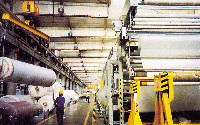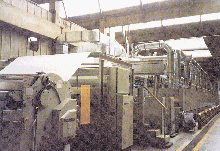Since its founding in the 1970s by a family of entrepreneurs, the Cuvio, Italy, dyehouse Mascioni
has endeavored to strike a delicate balance between the demands of production and the issues of
safety, health and environment. Mascioni was founded during a politically sensitive time for
Italian manufacturers. Textile plants and other manufacturing concerns that indiscriminately
discharged waste into the formerly pristine rivers and streams of the Italian countryside were
coming under increasing pressure by government, environmentalists, outdoorsmen and others. The
conflict resulted in the passage by the Italian government of the Merli Act, which put in place
much more stringent wastewater requirements.We should still be grateful to and appreciate the
foresight of our predecessors in corporate management, said Dr. Carlo Mascioni, the companys
current managing director. While the environmental controversy was at its height, the Mascioni
facility was under construction. Company founders had already decided to invest in a wastewater
purification system significantly larger and more advanced than was the norm. This, says Dr.
Mascioni, turned out to be a tremendous strategic advantage for the companys
prosperity. Garnering Respect From The CommunityThe initial construction of the facility was
followed by the building of a cogeneration plant in the 1980s that, at the time, was without equal
in Europe. These two facilities, both of which feature state-of-the-art technology in terms of
environmental protection, have enabled us to foster the excellent relationship that Mascioni has
always had with both the regional administrative bodies and the residents of the area, many of whom
are working with us, Dr. Mascioni said. These persons are aware of the attention we pay to
safeguard the place where they live, and they repay this heed with their attachment to the company.
We believe this to be an extremely important factor so much so that it is one of the most crucial
elements we take into consideration when deciding new investments.

It was in this light that Mascioni chose the Monforts Montex 5000 stenter. Mounted on the
Montex 5000 is a Koenig heat-recovery and fumes-purification unit.The line has been in operation
for less than a year and has resulted in sizeable operational and qualitative benefits, Dr.
Mascioni said. We are completely satisfied with it, he said. The results have exceeded
expectations, including the enhancement of the exhaust air quality.The fumes-treatment system by
Koenig has capability beyond the specific needs of the Montex 5000. It also recovers heat from an
older stenter installed in an adjacent room.The numeric evaluation of the operating economy is not
easy, Dr. Mascioni said, but we think we can anticipate a 30-percent savings in comparison with
previous installations. This enhances quality and allows a quick return on investment. Also, the
drying performance of the powerful Monforts stenter is considerable.Mascioni produces nearly 45
million meters of fabric (340 centimeters double width) per year. The company employs 450 people in
an 80,000-square-meter facility. The companys production program, which once consisted mostly of
printed cotton fabrics for household furnishings, is now diversified and includes technical and
apparel materials the result of research conducted jointly with customers. Approximately 70 percent
of Mascionis customers are outside Italy, with the majority in the United Kingdom, France and the
United States. New Machinery Improves EfficiencyNew production machinery has recently come
online at Mascioni, including a preparation and bleaching range, a hot-mercerization line, a modern
singeing machine, a two-phase development system and, of course, the new Montex 5000 stenter. The
plant runs 24 hours a day, five days a week, with three production shifts. The stenter is in
continuous operation. Before purchasing the Montex 5000, Mascioni carefully evaluated the units
running efficiency, quality, economy, reliability and environmental capabilities. The
seven-compartment machine operates at speeds ranging from 80 to 120 meters per minute (m/min),
depending on fabrics being produced, and has successfully replaced an existing 10-compartment
stenter, the speed of which reached only 60 m/min. In addition, it offers a series of technical
solutions, such as high operating flexibility, user-friendliness, very low consumption and minimal
maintenance.

Worthy of mention, especially, is the great advantage of having an efficient automatic
cleaning filter, an independent air flow (of both upper and lower nozzles), an electronically
controlled process, with the guarantee of a perfect lot reproduction even after a long time, said
Fiorenzo Fumagalli, the plants production manager. The Koenig system has fully come up to our
expectations; we are really satisfied with it.Mascioni bought the Montex 5000 at ITMA 99 in Paris.
It began working at full production capacity in January 2000 and has been running trouble-free ever
since, according to Fumagalli. It operates my favorite way that is to say, install it and forget
about it.
January 2001




